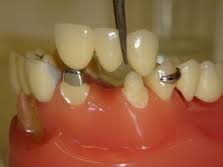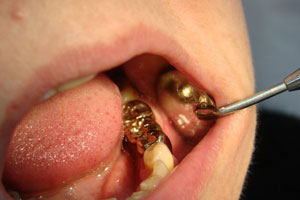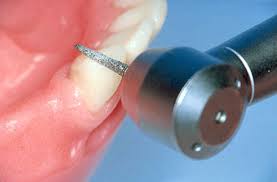Solid cast bridges

Cast bridges are made of various alloys by casting.
Solid castings are cast as a single unit. This eliminates soldering, heterogeneity of metals, as well as manufacturing errors.
Most often, gold, silver - palladium or cobalt - chrome alloys are used for the manufacture of the structure.
Depending on the client’s desire, a prosthesis made of cobalt-chrome alloy can be:
- In pure form.
- Gold plated.
- Lined with ceramic or plastic on the front surface or on all sides.
Benefits
All-metal bridge has advantages:
- Restoring the dentition while maintaining function.
- Due to the tight fit on the abutment teeth, saliva, microorganisms and food debris under the construction are completely excluded.
- The durability of the prosthesis due to its high strength and resistance to wear.
- High structural strength due to the absence of solder.
- In the manufacture of the prosthesis, simultaneous accurate modeling of the intermediate part and the supporting crowns is performed, which increases its functional efficiency.
- When grinding the tooth under the crown, most of the tooth tissue is retained.
- Affordable price.
disadvantages

- Low aesthetics of the structure, in connection with which fixed cast prostheses are used for prosthetics of teeth that do not fall into the smile zone.
- High thermal conductivity of the metal. The appearance of discomfort while eating hot food.
- The need for the preparation of supporting teeth.
- If the bridge is improperly designed, periodontal overload is possible.
- Cost is higher than removable designs.
- Over time, loosening and damage to supporting teeth from increased load are not excluded.
- Difficulty in hygienic oral care.
Contraindications
Contraindications to the installation of a bridge can be absolute and relative.
It is not possible to install the structure in the following cases:
- In the absence of more than one molar, two premolars and four incisors in a row.
- With osteomyelitis or osteoporosis of the jawbone.
- If there is a bleeding disorder.
- With intolerance to the drugs used for anesthesia.
- The presence of cancer.
- Mental disorders.
Relative contraindications to the installation of the bridge are:
- Involuntary grinding of teeth (bruxism).
- Malocclusion.
- Periodontal disease (periodontal disease and periodontitis severe).
- Increased tooth abrasion.
- Acute inflammatory diseases of the oral cavity.
- Poor oral hygiene.
Indications
The installation of a cast prosthesis is indicated in the following cases:
- Defects in individual teeth and dentition.
- Tooth injury.
- Caries.
- Replacing previously manufactured bridge structures.
Making a one-piece bridge
Stages fabrication designs include:

- Inspection and diagnosis of the condition of individual teeth and dentitions. After the examination, if necessary, treatment of abutment teeth, root canal filling is performed.
- Periodontal assessment. In the presence of pathological processes, gum treatment is performed.
- Preparation of supporting teeth. Their grinding is carried out and, if necessary, depulpation.
- Impression of the upper and lower jaws and sending them to the laboratory.
- In the laboratory, models of jaws are made on which the frame of the future structure is formed.
- Casting a metal frame.
- Color matching of facing ceramics.
- Fitting and fitting the bridge structure. Checks the closure of teeth with teeth of the opposite jaw, the aesthetics of the design. If necessary, a correction is made.
- Fixing a bridge with cement.